In the world of business, understanding your customers is key to success. One of the most effective tools for gaining insights into customer satisfaction is the Customer Satisfaction survey. These surveys are designed to measure how satisfied customers are with your products, services, or interactions.
Creating a satisfaction survey involves more than just asking a few questions; it requires careful consideration of question design, survey distribution, and data analysis methods. In this blog, we will look at how to create a customer satisfaction survey that can help you capture the voice of customer powerfully and directly, setting you on the course to exceptional service improvement.
TL;DR
-
CSAT surveys help businesses measure and understand customer emotions, which directly impact business growth and customer loyalty.
-
Before crafting a survey, it’s important to set clear objectives, target the right audience, and choose the appropriate survey methods to acquire reliable and actionable data.
-
Questions in the satisfaction survey must be clear, concise, and topic-specific to avoid confusion and bias, leading to actionable insights.
-
A well-designed, brand-customized, mobile-friendly survey can improve survey response rates and user engagement, while the analysis of survey results should inform actionable business decisions.
-
Zonka Feedback is an effective survey tool that can help you create effective customer surveys in no time and share them with target customers and collect valuable information. Schedule a demo to get started with creating customer surveys.
Create CSAT Surveys & Measure Customer Satisfaction
Understand what your customers need and learn ways to delight them.

Why are Customer Satisfaction Surveys Important?
A customer satisfaction survey help businesses gauge how happy customers are with their products, services, or overall experience. They ask customers to rate satisfaction levels on aspects like product quality, customer service, pricing, and overall experience.
The feedback gathered from these surveys is used to identify areas for improvement and make informed decisions to enhance the customer experience.
Here's why you must consider implementing a customer satisfaction survey for your business.
-
Quantifying Customer Emotions: They help convert customer emotions into quantifiable CX metrics, such as Customer Satisfaction Score or Net Promoter Score. By quantifying satisfaction levels, businesses can track the impact of UX/UI strategies and compare satisfaction across different channels, ultimately improving overall management.
-
Measuring Experience: Customer surveys provide a comprehensive view of customer interactions, allowing businesses to measure customer satisfaction in both transactional and overall experiences. This understanding helps predict long-term loyalty and retention rates, vital for business growth.
-
Audience Segmentation: Satisfaction surveys help segment audiences, helping in brand growth and personalized user experiences. They also facilitate the collection of reviews and testimonials, further enhancing brand reputation.
-
Enhancing Business Performance: By analyzing customer satisfaction data, businesses can show empathy, understanding, and a willingness to resolve issues promptly. This underscores the significance of creating customer satisfaction surveys in enhancing satisfaction, loyalty, and ultimately, growth.
Key Factors to Consider Before Creating a Survey
Before developing your customer satisfaction survey, you should take into account a few essential factors. Each of these elements plays a vital role in ensuring that your survey provides reliable, insightful, and actionable data. Let us look at each of them.
#1. Define Clear Objectives
The initial step in formulating a customer satisfaction survey is to establish precise objectives, which help in collecting detailed data and identifying areas that necessitate improvements in customer experience.
-
Set SMART goals (Specific, Measurable, Achievable, Relevant, Time-bound) to collect detailed data and identify areas for improvement.
-
Align customer satisfaction survey goals with business objectives to make insightful decisions and enhance services. This, in turn, can result in increased NPS, better customer effort scores, and successful training programs for your team.
-
Focus on understanding specific aspects of the customer journey, like feedback channels and consistency across touchpoints that are crucial for trust-building and customer retention.
#2. Target the Right Audience
When you identify the appropriate audience and segment customers for your customer satisfaction survey, you can gather relevant feedback, ensuring that the insights you gain are applicable and actionable. You need to
-
Understand customer demographics, purchase history, and engagement level for effective audience selection.
-
Consider the customer journey stage (new or long-term) and use segmentation and personas for specific results, reducing bias.
-
Aim for a sample size of 200 to 300 responses for reliable results, adjusting based on incidence rate calculations.
-
Use screening questions to enhance participant experience and reduce bias, collaborating with market research partners and secondary resources for deeper insights.
-
Avoid repeatedly surveying the same customers at every stage of their journey. Instead, determine the optimal times to deliver surveys to gain the most valuable insights from existing customers.
#3. Choose Appropriate Survey Methods
Choosing an appropriate survey method is crucial in a customer satisfaction survey as it directly impacts the reliability of the survey data collection, the engagement of respondents, and the effectiveness of addressing specific customer concerns, which ultimately leads to improved business strategies and customer relationships. You should
-
Select methods based on study objectives, respondent demographics, and data type for accessibility and appeal.
-
Ensure compatibility with company technological infrastructure and resource availability for efficient data management.
-
Opt for online and mobile surveys in areas with good internet access as they are cost-effective and quick.
-
For hard-to-reach populations, choose paper surveys and face-to-face interviews but can be more time-consuming and expensive.
-
Use advanced survey software with multi-mode capabilities to facilitate a combination of different survey methods like online, email, SMS, in-app, and survey apps to address diverse respondent needs.
Crafting Effective Customer Satisfaction Survey Questions
The process of creating effective customer satisfaction survey questions includes adding good questions as they prevent confusion, reduce survey fatigue, and ensure a healthy response rate and actionable insights. Your survey question must be clear, concise, and stick to one topic per question to avoid muddled data, improve clarity, and prevent biased responses.
This section will delve into the different types of questions you can use and provide tips on how to write clear and unbiased questions.
Types of Questions
The types of survey questions you choose play a crucial role in measuring overall satisfaction accurately. Single-choice questions are ideal for simple queries and allow for easy analysis of the data collected. On the other hand, multiple-choice questions offer survey respondents the flexibility to choose more than one answer, providing a broader insight into their preferences.
Add different types of survey questions to collect feedback from your target market. These can include:
a. Likert Scale Questions
These questions are structured to measure the intensity of how customers feel towards a particular statement, with a series of ordered response options. Questions in a Likert scale surveys to gauge overall satisfaction can include:
-
Please indicate how satisfied you are with our product/service overall (on a scale of very dissatisfied to very satisfied)
-
How likely are you to recommend our product/service to a friend or colleague? (Range can be not at all likely to extremely likely)
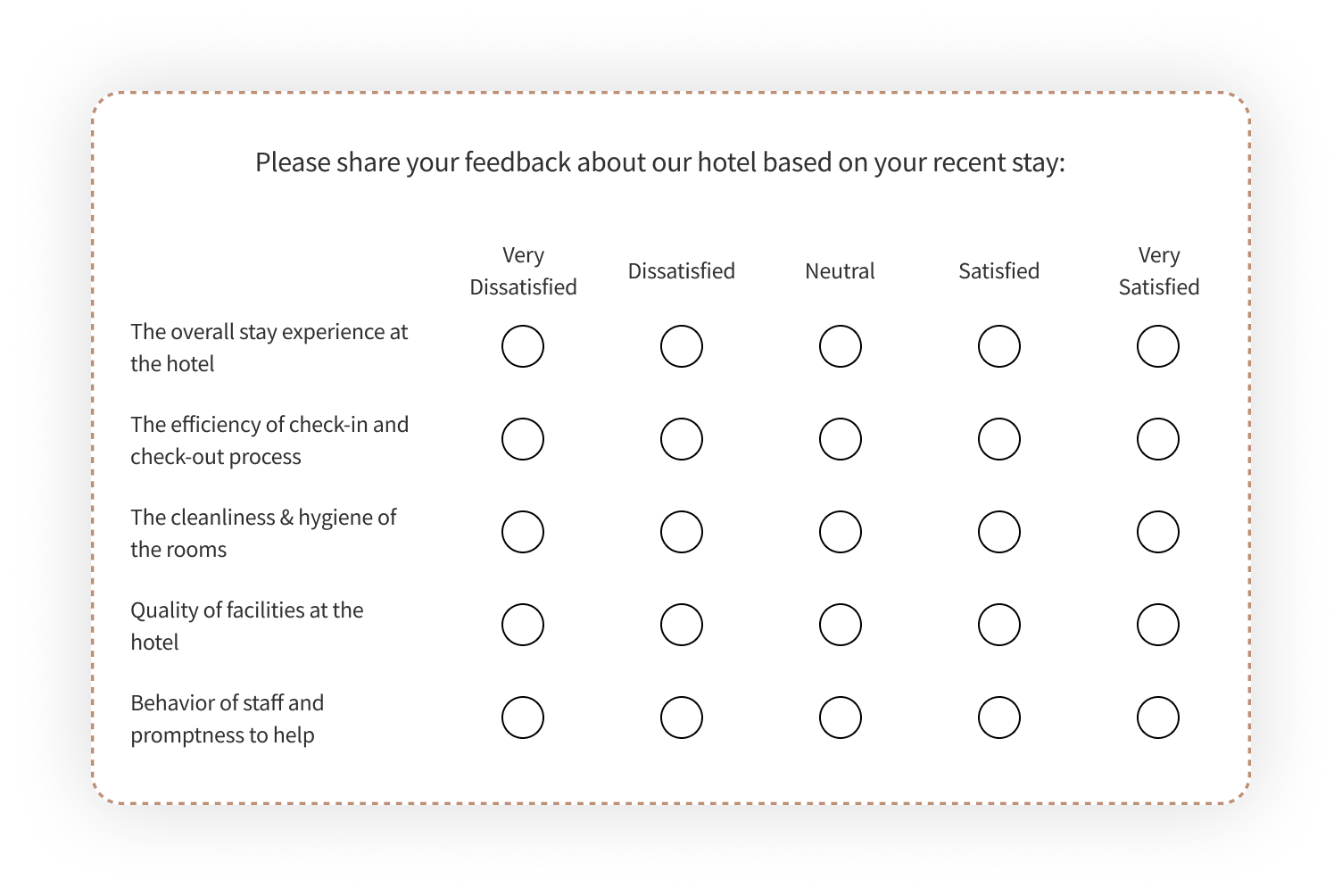
b. Dichotomous questions
These questions offer two opposing choices, simplifying the analysis process by segmenting the audience. Questions in a yes no surveys can include:
-
Would you purchase from us again in the future?
-
Was our website easy to navigate?
-
Are you satisfied with your hotel experience?
-
Was your issue effectively resolved to your satisfaction?
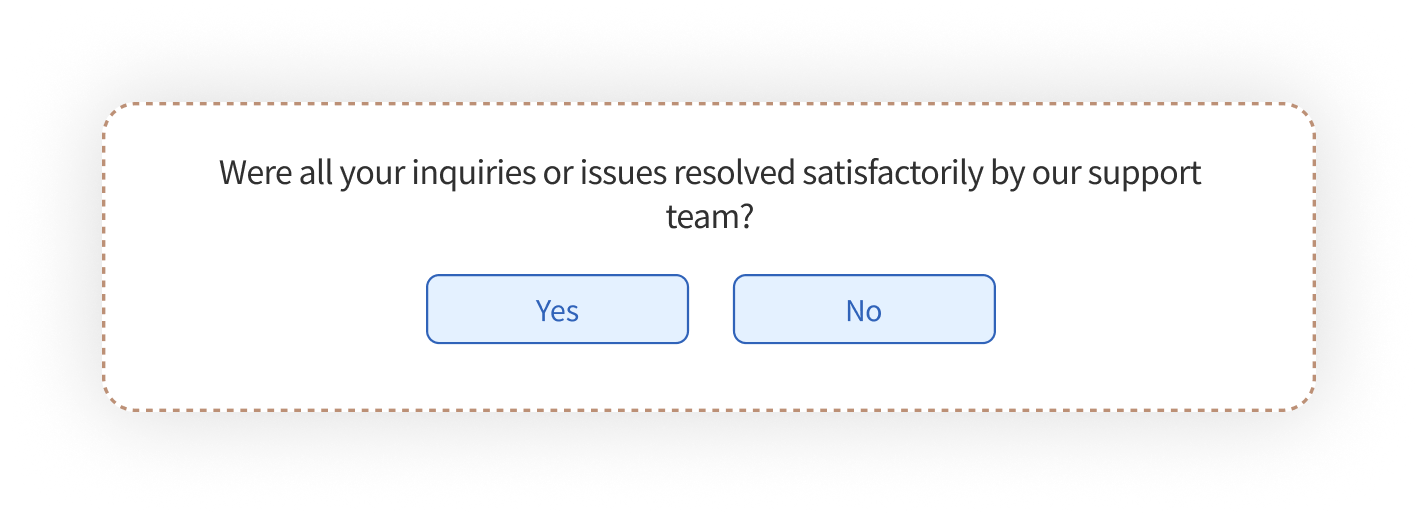
c. Rating Scale Questions
They use visual representations to allow respondents to indicate their level of satisfaction or agreement along a satisfaction scale, typically ranging from negative to positive or low to high. These can include:
-
Smiley Face: Smiley surveys are a simple way to gauge sentiment, often ranging from sad to happy faces.
-
Star Rating: A widely recognized method where respondents rate something on a scale of 1 to 5 stars.
-
Numeric Rating: Using numbers to rate or rank items, often on a scale from 1 to 10.
Some questions for customer satisfaction surveys for a corresponding survey rating scale can include:
-
How satisfied are you with our product?
-
How would you rate the quality of our product?
-
How would you describe your delivery experience?
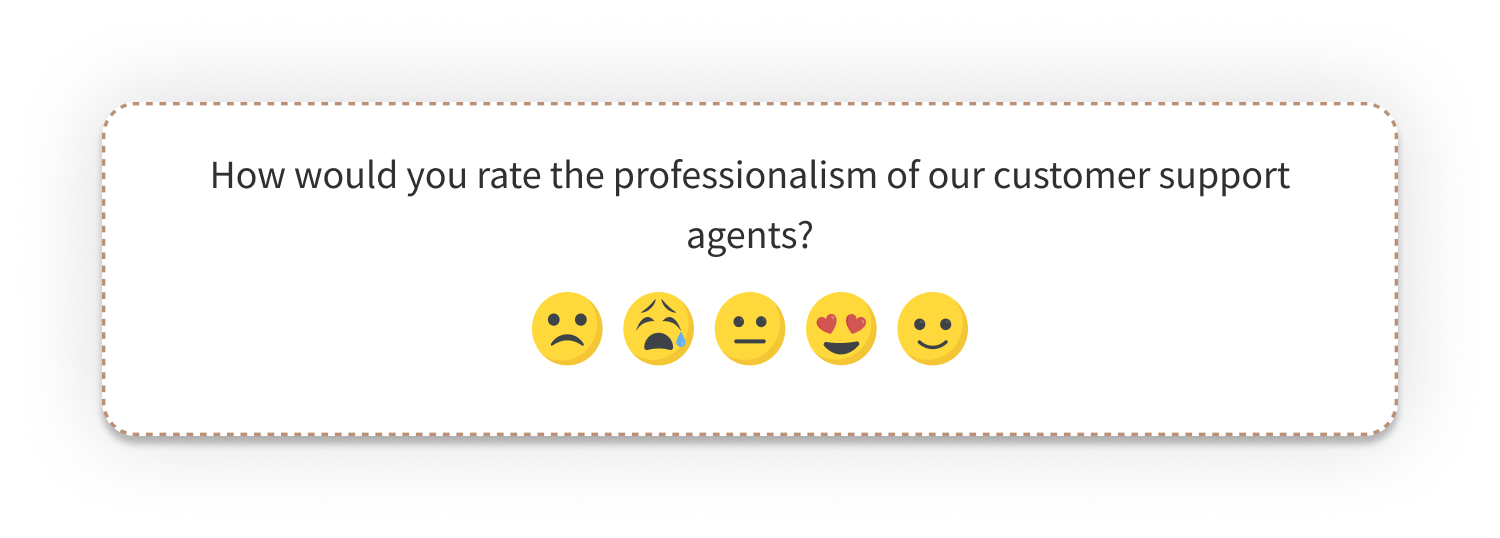
d. CX Metric Questions
These are questions designed to measure various aspects of the customer experience (CX) and are used to assess customer satisfaction, loyalty, and overall experience with a product or service.
-
Net Promoter Score: The Net Promoter System measures customer loyalty based on the likelihood of recommending a product or service.
-
Customer Satisfaction Score: A CSAT survey measures satisfaction with a product or service based on customer responses.
-
Customer Effort Score: A CES survey measures the ease of customers' interactions with a company.
Questions can include:
-
NPS: How likely are you to recommend our company to a friend or colleague?
-
CSAT: How satisfied are you with your experience with our customer service?
-
CES: How easy was it to resolve your issue with our product/service?

e. Open-ended Questions
These questions allow respondents to provide their answers in their own words, offering more valuable insights but requiring more effort to analyze due to the varied nature of responses. You can consider these open-ended questions:
-
What motivated you to use our product/service?
-
What do you think sets us apart from our competitors?
-
Is there a specific feature or aspect of our product/service that you particularly like?
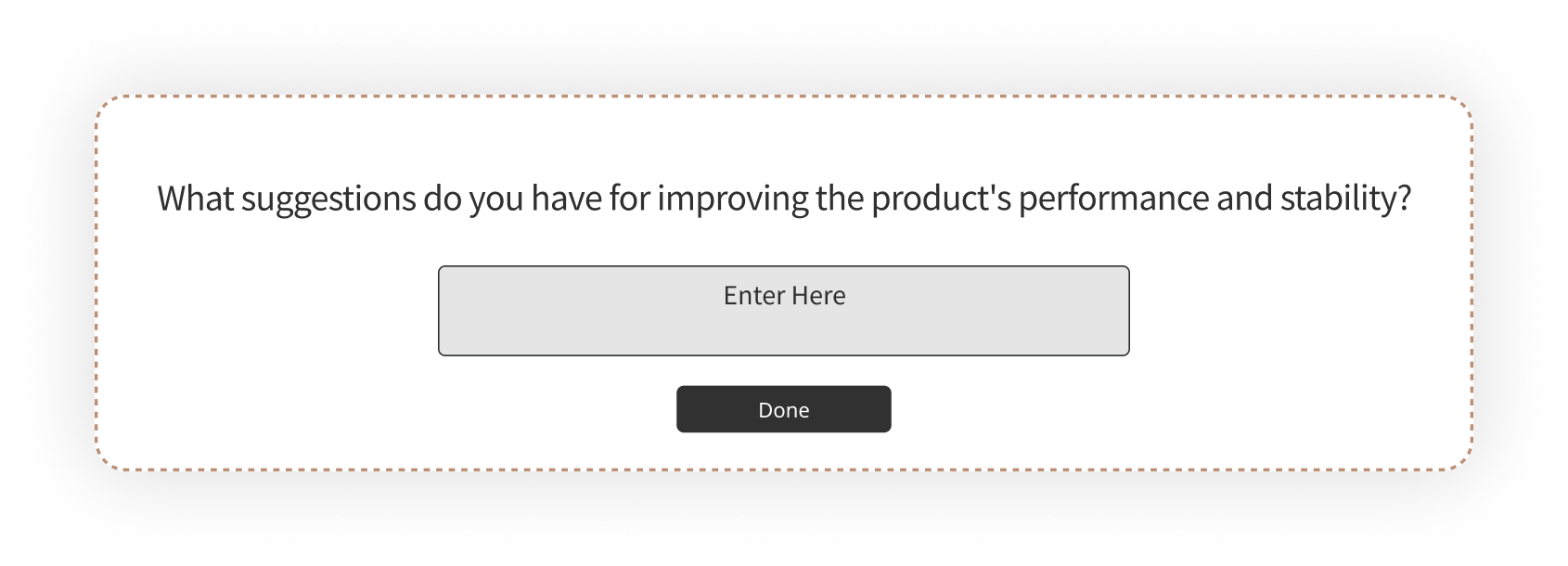
Tips for Writing Clear & Unbiased Questions
Creating clear and unbiased questions is an essential aspect of creating an effective customer survey. One key tip is to avoid using positively charged adjectives or absolute terms in questions. This prevents you from leading respondents or assuming certain behaviors, and enables them to express their true experience accurately.
Ensure your survey questions meet the following criteria:
-
Clear and specific
-
Free of poor grammar or technical jargon
-
Straightforward and considerate of your respondents’ understanding
-
Unambiguous, non-overlapping, and comprehensive
Following these guidelines reduces the possibility of misinterpretation and bias.
Lastly, structure your survey with a logical progression from broad closed-ended questions to more specific ones, finishing with open-ended questions for in-depth and valuable insights.
Designing a User-Friendly Survey
Creating a user-friendly survey holds equal importance as formulating effective questions. A well-designed survey improves response rates and expedites the identification and resolution of negative feedback. Let us look how you can do this.
#1. Keep it Short and Simple
Maintaining a brief and straightforward survey is pivotal to avoid survey fatigue and enhance completion rates. Here are some tips to achieve this:
-
Limit the number of questions to under 15
-
Keep the survey duration to under 10 minutes
-
Respondents typically spend about 5 minutes completing a 10-question survey
-
Include multiple-choice options or text boxes for free-form opinions.
To get an idea of what to include in your survey, you can refer to a customer satisfaction survey template or customer satisfaction survey examples available online.
#2. Customize to Match Your Brand
Customizing your survey to match your brand boosts recognition and connection with respondents. Consistent branding in survey images and messages builds trust and loyalty mong your target audience.
A strong brand identity, reflected in your survey design, can lead to the development of customer relationships and the ability to turn potential prospects into customer base.
#3. Ensure Mobile Compatibility
Mobile-friendly surveys with intuitive navigation engage customers effectively by leveraging their smartphone familiarity. Optimized for mobile devices, these surveys capture accurate feedback by minimizing disruption.
Responsive surveys cater to both computer and mobile users, enhancing accessibility. Ensure easy navigation on smaller screens to boost completion rates.
Analyzing and Acting on Survey Results
After gathering your survey results, the subsequent step involves analyzing the data and taking action based on the feedback. The insights from the surveys can inform business decisions, improve customer experiences, and address negative feedback.
Data Analysis Techniques
Quantitative and qualitative data analysis methods can uncover user insights and trends. Using a software tool like Zonka Feedback can help you interpret quantitative and qualitiative data from customer surveys and avoid common qualitative analysis mistakes that can distort your findings.
-
Quantitative analysis involves measuring and counting responses and converting them into numbers and statistics.
-
Qualitative analysis includes transcribing and labeling feedback and sorting data based on research question to identify themes. This is also where teams are most prone to qualitative analysis mistakes, such as mislabeling themes, overlooking sentiment nuance, or relying too heavily on generic tags.
-
Tools like rule-based AI and sentiment analysis categorize feedback to identify customer sentiments and trends, but to get reliable results, you need to be mindful of these mistakes and refine your approach continuously.
Taking Action Based on Feedback
Conducting regular customer satisfaction surveys, as well as customer feedback surveys, shows your customers that their opinions are valued which shapes the customer lifecycle value and promotes brand loyalty. By analyzing customer satisfaction feedback, you can identify areas for improvement and ensure a positive experience for your clientele.
Investing in the training and development of your customer service teams is key to successfully resolving issues, elevating customer satisfaction levels, and ensuring customer and client retention. Implementing changes based on customer feedback through methodical checklists can guide logical enhancements to the overall customer experience.
Creating a Customer Satisfaction Survey using Zonka Feedback
Creating a customer satisfaction survey with Zonka Feedback is super easy and all you need to do is foolow some basic steps and your survey would be ready to go live. Let us look at these steps:
Step 1: Create your Zonka Feedback Account
Create an account. You will be directed to the dashboard from where find and select 'Add Survey' option.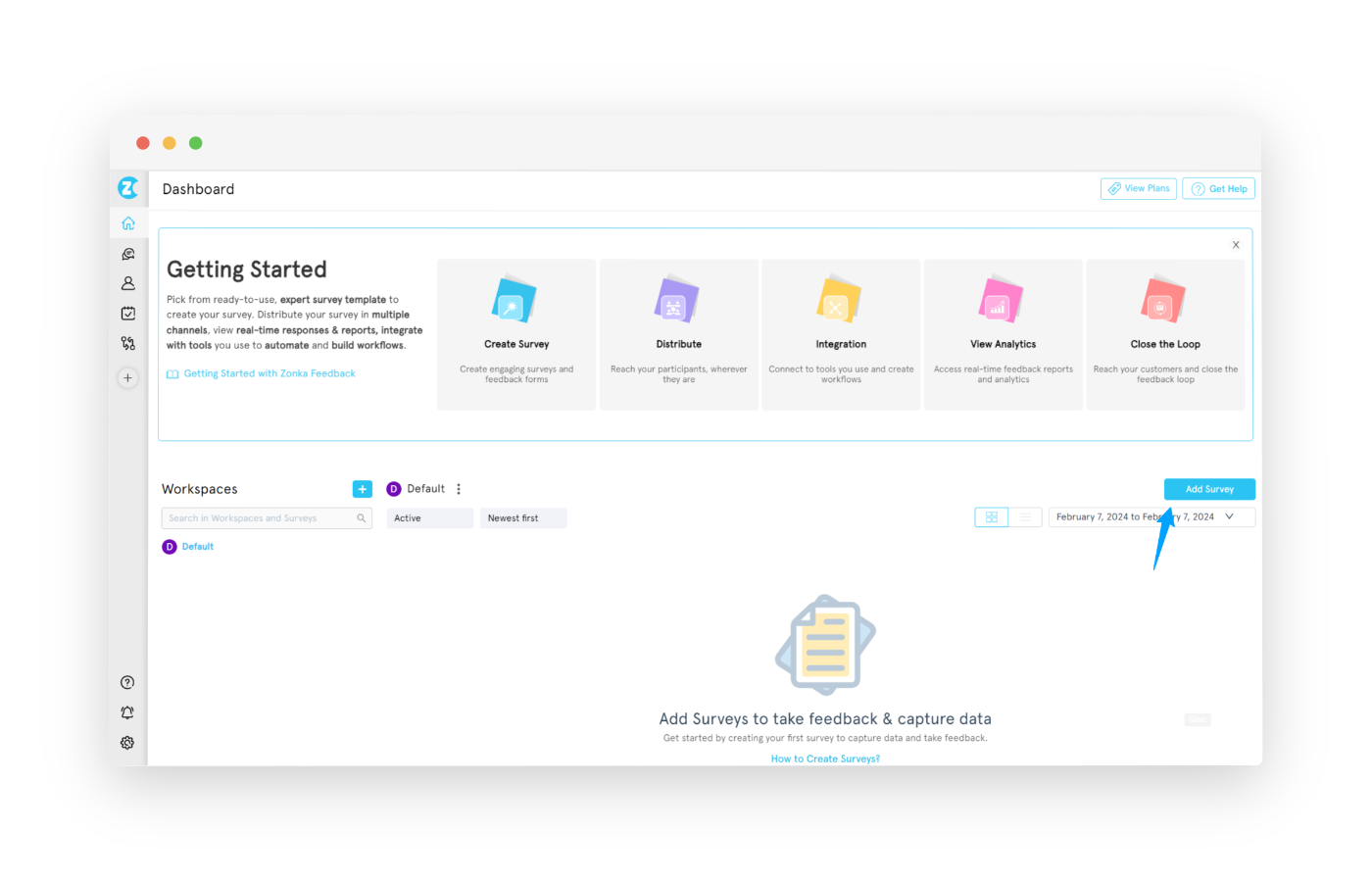
Step 2: Choose Customer Satisfaction Template
-
You’ll be redirected to the Zonka Feedback survey template library which has over 500+ survey templates.
-
Select Customer Satisfaction Score survey template.
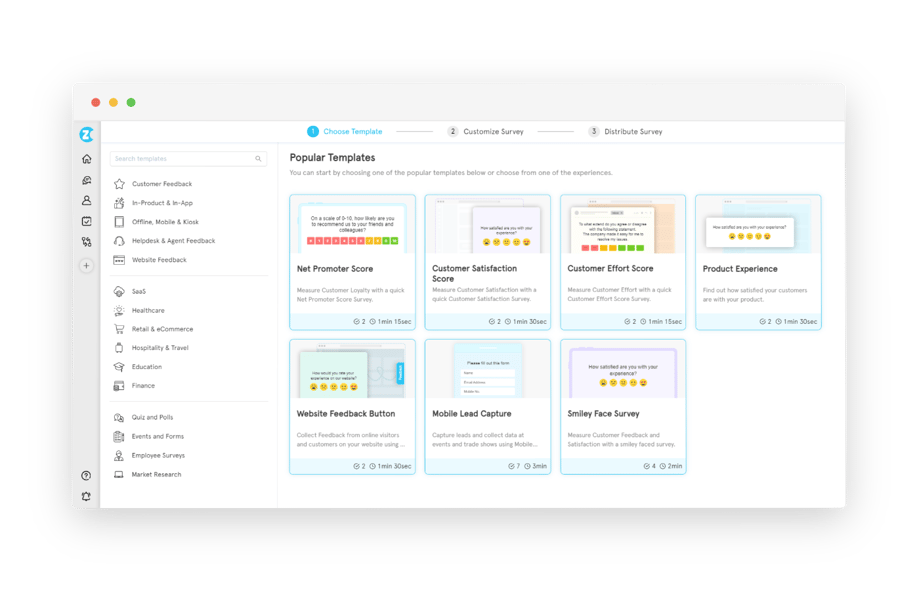
Step 3: Customize Survey Template
-
The Customer Satisfaction survey templates include a standard question, which you can customize.
-
Modify question types (e.g., button-choice, rating scale) to gather specific information.
-
Personalize the question and add follow-up queries for deeper insights.
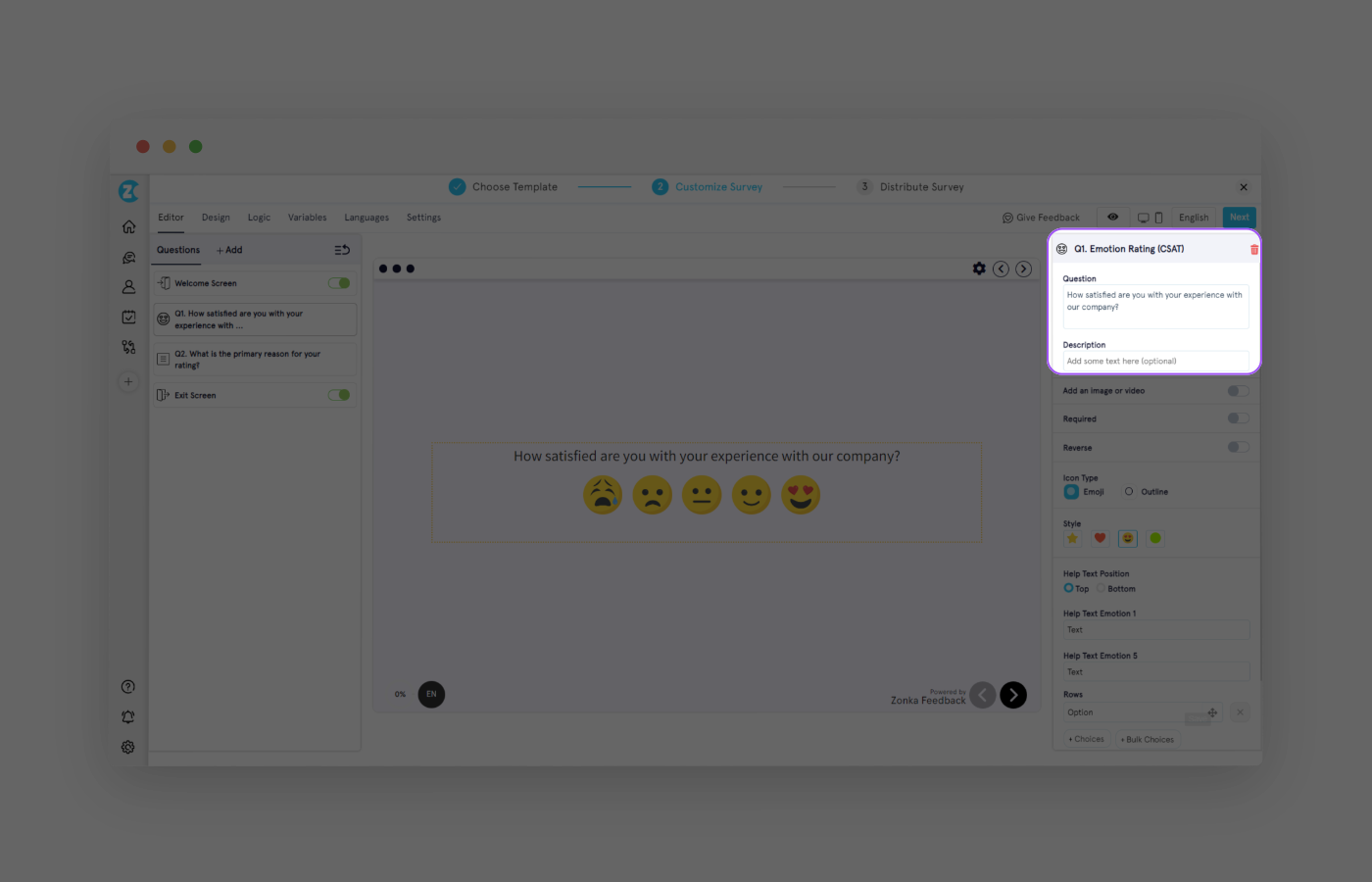
Step 4: Customize Survey Design
-
Align the survey design with your brand identity.
-
Add your company logo, choose colors, and select fonts that reflect your brand's personality.
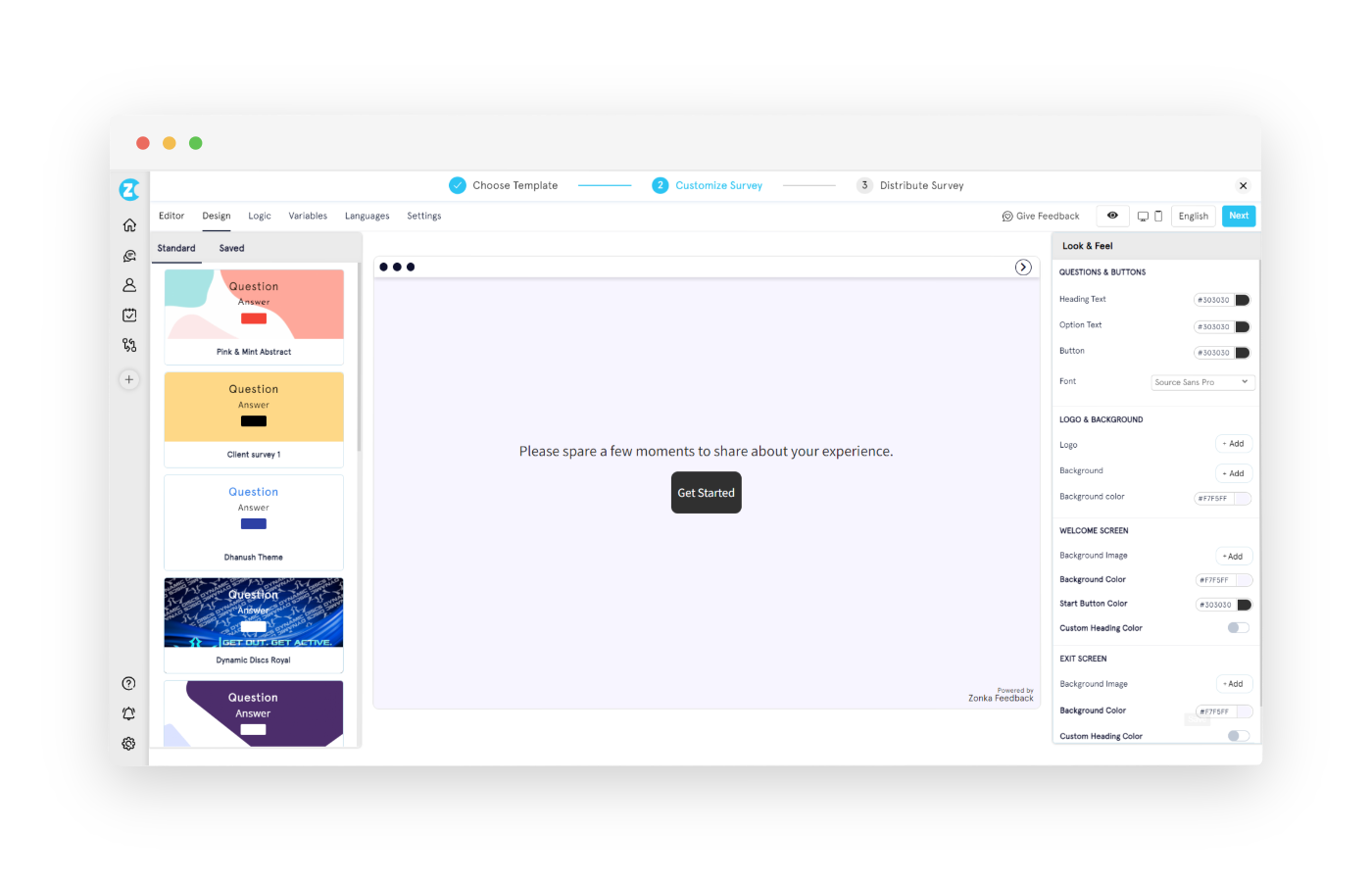
Step 5: Add Skip Logic
Use logic rules to trigger actions based on respondents' answers. For example, you can create logic to show a different question if the Customer Satisfaction score is below a certain point.
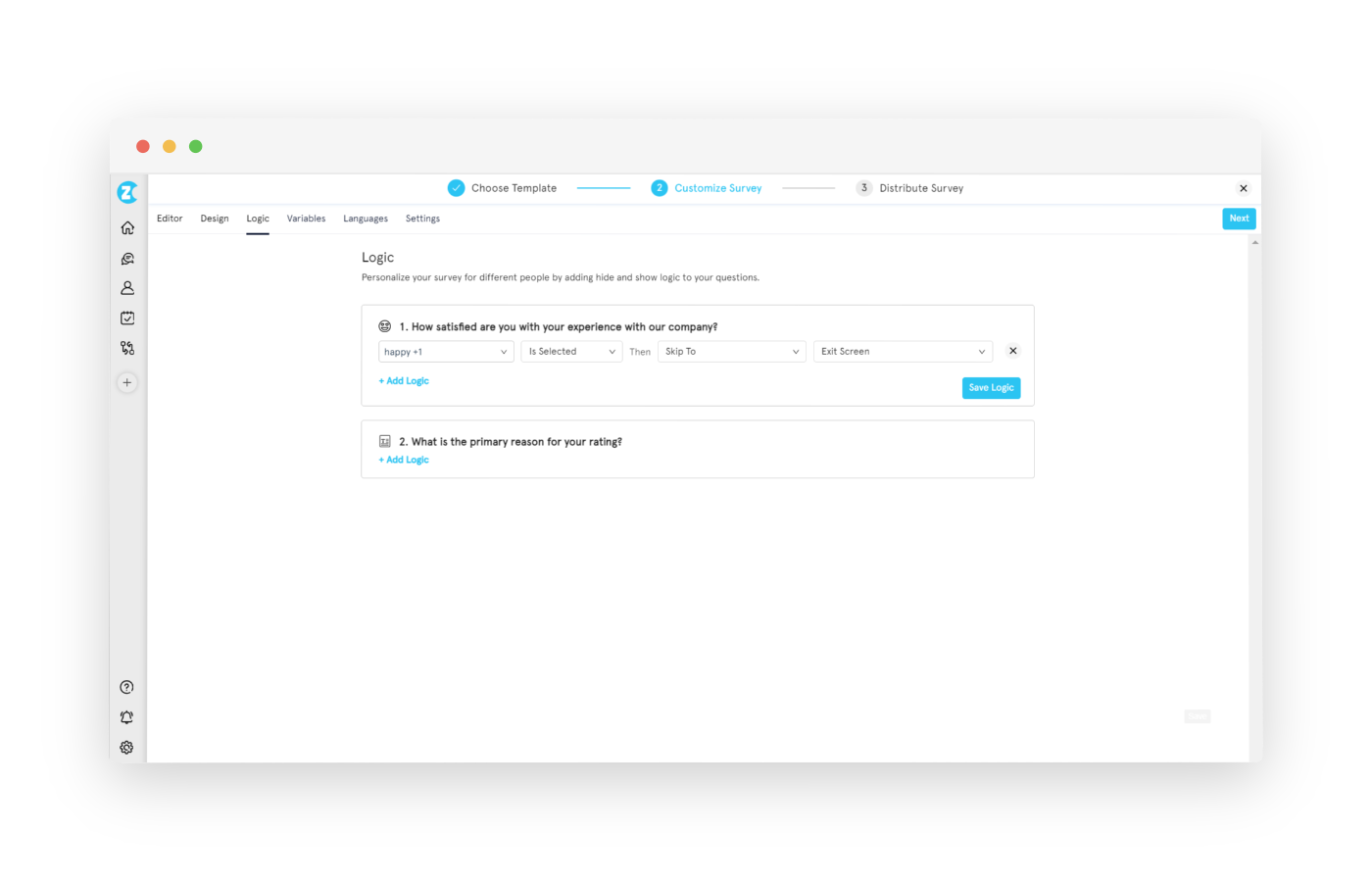
That's it, your customer survey is ready to be shared. You can choose the survey distribution channel based on your preference (whether email, in-app, website, SMS, or offline) and start collecting feedback immediately.
Conclusion
Mastering insights from customers through customer satisfaction surveys is a vital process for any business in today’s competitive environment. By creating clear and unbiased questions, targeting the right audience, and utilizing the appropriate survey methods, businesses can collect valuable feedback.
By using customer satisfaction survey software like Zonka Feedback, you can easily create satisfaction surveys and enhance overall performance including your customer service team and share them to get detailed feedback.
Schedule a demo and start collecting feedback to witness transformation in customer's experience and satisfaction levels.


.png)
.jpg)






.jpg)